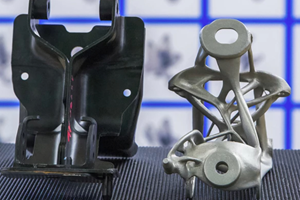Horizon Demonstrates Effectiveness of HMT-Metal Coating Process for Plastic Micro Additive Manufacturing Parts
The ability to make mm-wave components via micro-additive manufacturing enables the production of smaller and lighter weight components, and also opens up the possibility of making them with properties and geometric features impossible using alternative fabrication processes.
Horn antenna made via micro-AM and coated in Horizon’s copper coating. Source: Horizon Microtechnologies
Horizon Microtechnologies has completed its rigorous functional testing to prove the effectiveness of its HMT-Metal coating process for making high-frequency D-Band horn antenna via 3D printing.
The company says it was founded on the understanding that microscale manufacturing using micro-additive manufacturing (AM) technologies would be optimized through the integration of a number of technologies and processes. Building on the ability of today’s micro-AM technologies to build precise parts with micron-level tolerances repeatably, Horizon’s proprietary coating technologies successfully expands the functionality of parts which are typically produced in plastics on commercially available micro-AM platforms.
“The work on the high-frequency D-band horn antenna used our HMT-Metal coating process with which copper layers can be applied very evenly and conformally to a variety of component shapes and materials,” says Andreas Frölich, Horizon CEO. “From a commercial perspective, such components fit well with the use of micro-AM as they are typically in the cm size range, with sub-mm dimensions, and require the attainment of micron tolerances. The market demands such antenna and other mm-wave components to exhibit higher frequencies and connectivity for use in industrial measurement technology, sensor technology and communication applications with very low latencies.”
Being able to make such mm-wave components via micro-AM enables the production of smaller and lighter weight components, and also opens up the possibility of making them with properties and geometric features impossible using alternative fabrication processes.
The performance of an antenna depends on a large number of component properties that are difficult to measure and calculate directly such as the conductivity of the metallic layers, layer thicknesses, layer thickness homogeneity, dimensional accuracy of the antenna and surface roughness. Instead of an elaborate determination of all these properties, Horizon undertook a functional comparison of its copper coated micro-AM produced horn antenna with a traditionally produced commercially available antenna, a pragmatic approach which enabled Horizon to prove its manufacturing technology is sufficiently good to serve high frequency and antenna applications.
Measurements were made of the radiation pattern (how much signal goes out of the antenna and in which direction) and the so-called S11 parameter (how much of the signal is reflected back from the antenna into the transmitter). The directivity of the antenna (how much signal goes in the forward direction) and the S11 parameter can be compared clearly and directly with traditionally produced antennas, and the test showed that the Horizon antenna had approximately the same directivity and a better S11 parameter.
“Successful testing should indicate a high gain value in the forward direction and as little back reflection as possible. We are delighted to say that after testing, our micro-AM copper coated horn antenna performed as well as a conventionally built horn antenna, removing many of the reservations that 3D printed devices are often faced with,” Frölich says. “This opens up some very interesting opportunities as companies requiring horn antennas and other mm-wave components can now exploit the process advantages of micro-AM by partnering with Horizon as their development and manufacturing partner.”
Frölich says the company didn’t even perform full-blown dedicated additive design-thinking efforts for the antenna because it wanted to fabricate something emulating the conventional counterpart. “Yet we have an antenna that weighs only a sixth of its conventional counterpart and takes up 15% less space,” Frölich adds. “This is a powerful indication of the kind of benefits that dedicated AM-based component design-thinking could achieve.”
Related Content
3D Printed Metal Component for CNC Machining Center: The Cool Parts Show #47
Machine tool maker DMG MORI improved this coolant delivery adapter by making the part through additive manufacturing instead of machining. One of the viewer-chosen winners of The Cool Parts Showcase.
Read MoreXJet Produces First Entirely Ceramic Piston for Chaos Ultracar
Company says no other technology could achieve the accuracy and complexity required to create Spyros Panopoulos Automotive’s lightweight ceramic design.
Read MoreHow Additive Manufacturing Is Transforming EVs and Transportation: AM Radio #23
As 3D printing is adopted into the electric vehicle (EV) market, it is not just vehicles that are being reshaped. In this episode of the AM Radio podcast, we discuss additive manufacturing and the future of transportation.
Read MoreVelo3D Founder on the 3 Biggest Challenges of 3D Printing Metal Parts
Velo3D CEO and founder Benny Buller offers this perspective on cost, qualification and ease of development as they apply to the progress of AM adoption in the future.
Read MoreRead Next
At General Atomics, Do Unmanned Aerial Systems Reveal the Future of Aircraft Manufacturing?
The maker of the Predator and SkyGuardian remote aircraft can implement additive manufacturing more rapidly and widely than the makers of other types of planes. The role of 3D printing in current and future UAS components hints at how far AM can go to save cost and time in aircraft production and design.
Read More3D Printing Brings Sustainability, Accessibility to Glass Manufacturing
Australian startup Maple Glass Printing has developed a process for extruding glass into artwork, lab implements and architectural elements. Along the way, the company has also found more efficient ways of recycling this material.
Read MoreHybrid Additive Manufacturing Machine Tools Continue to Make Gains (Includes Video)
The hybrid machine tool is an idea that continues to advance. Two important developments of recent years expand the possibilities for this platform.
Read More








.png;maxWidth=300;quality=90)















